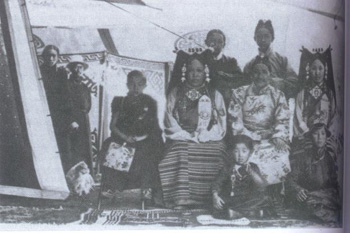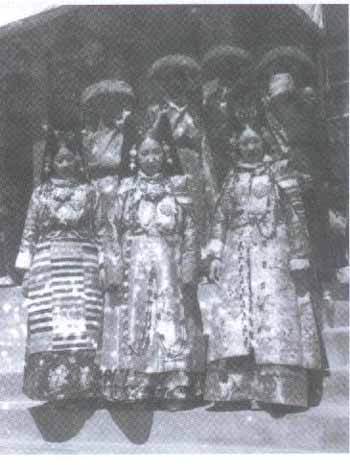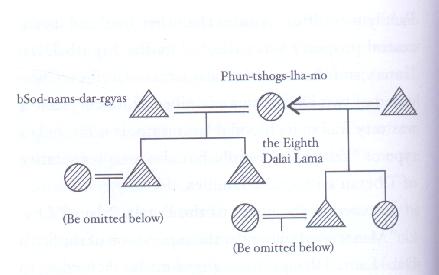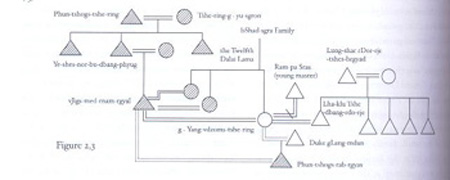
Social relationships mean different things to different people. Any observation of social life has to include recognition of the existence of "the family." "Family" is not only a biological group created by a sexual union, but also a social organization established through relative social networks. In any social system or in any nationality, the "family" serves as the foundation and mainstay of social life. Therefore, the "family" attracts attention from anthropologists, sociologists and historians at the outset of their investigations. As a region inhabited by Tibetans, "family" in Tibet not only refers to one household inhabited and inherited by members of the same blood relationship, but also shows peculiar Tibetan cultural elements, such as folk culture, moral principles and religions.
In a modern sense, there are no definite concepts of "family". Generally speaking, "family" is a stable, comparatively static entity. It is also a basic social organizational unit where people, tied by blood relationship, live and consume under the same roof. "Family" is called "Mi-tshang" or "Khyim-tshang" in Tibetan language. Literally, "Mi-tshang" means a "hu-man nest", while "Khyim-tshang" refers to a "house-hold cave". While carrying on her investigations on marriage and family conditions in Tibet, Ms. D.N.Aziz, an American anthropologist, could not refrain from pointing out with some emotion that family titles given by Tibetans are expressed in perfect metaphors. These titles reveal identical living patterns and social units of rich significance. In addition to these two concepts (Mi-tshang and Khyim-tshang), Tibetans usually use "Nang" (interior or inside) or "Them-pa" (threshold) to name their families, which accurately describes their view of a family. However, in Tibet, whenever people mention a certain household, they would use" gZims-khang" (bedroom), a term of respect, to show their esteem. No matter what titles Tibetans use, "family" definitely contains different connotations from those understood by society in the outside world. Thus it can be seen that the concept of a family in Tibet represents an inherent relational clique or a living unit. But during the period of the feudal serf system in Tibet, according to different social positions, classes and stratums, "family" was given different meanings. In a feudal serf system society, to serfs "family" was mainly a production unit, but to influential serf-owners and aristocrats in the upper social strata, its meaning was related to property or privileges and it had different titles. When people mentioned a certain aristocratic family, they would use such terms as "gZims-zhag" (mansion) or "Mi-tshang-chen-po" (wealthy and influential family). From this we can see that "family", in a sense, embodies people's standard of values, ideas and views as well as behavior patterns in that society at that time. Those who carry out research work on social patterns in the feudal serf system of Tibet necessarily have a better understanding of "family", a cell of society, especially for aristocratic families in that period. This area is where the author will concentrate this discussion.

1. Scope of Tibetan Aristocratic Families
As a special privileged stratum of feudal serf system society in Tibet, aristocrats were habitually referred to as "sGer-pa", "Mi-drag" or "sKu-drag". In Tibet, aristocracy came into being under feudalism due to repeated land-distributions and quantitative differences in status.
According to Tibetan myths and legends, the earliest aristocrats probably appeared in the period of Tubo bTsan-po gNyav-khri-btsan-po. Tradition has it that he descended to Earth from Heaven, becoming the first bTsan-po in the Tubo Kingdom. As a result, the difference between monarch and minister in Tubo emerged. gNyav-khri-btsan-po's descendants consisted of Tibetan sacred family members. Obviously, they were of aristocratic descent. In the reign of Srong-btsan-sgam-po, there appeared such privileged groups as "Zhang-blon", "Gung-blon" and "sPye-blon". In fact, they were Tibetan aristocrats of the early period. However, in a strict sense, aristocratic stratum came into being in the period between the late 17th century and the mid-18th century.1 Supported by the Qing Central Government, the dGe-lugs-pa Sect established dGav-ldan-pho-brang, a stable political system combining religious and political influence. The local government of Tibet conferred official titles upon some aristocrats who gradually formed a special class over 300 years. Over a period of social and historical changes, Tibetan aristocratic families went through many vicissitudes. Among more than 400 titled aristocratic families, only 197 were left at the beginning of the Democratic Reform2. Reform2. It is quite hard to explain the drop in numbers. According to the author's survey of the documents concerned, aristocrats in the local government of Tibet were usually made up of 1751 Tsedrung (monk officials) and 175 Shod-drung (lay officials). Definitely, Tibetan aristocrats were composed of two parallel stratum; lay officials and high-ranking monks. In this investigation, the author found that there were many families named "sGer-pa", for example, aristocratic officials in the regions under Panchen's jurisdiction in gTsang and Rin-po-ches, chieftains in Chab-mdo and Lho-kha as well as heads of 100 to 1000 households governed by 39 clans. Undoubtedly, there were aristocrats in local areas that enjoyed many privileges, but this privileged stratum was not strong enough to exclude other forces. It was made up of a few "sGer-pas" who found themselves in the center of the Dalai Lama clique and remained influential. Aristocrats ranked below them were scattered like a whirlpool with local aristocrats3 in its center. As Mr. May Goldstein (an American anthropologist) states, the aristocrats could be divided into different stratas.
In this study, the author detected different types of aristocracy, such as those attached to the local government of Tibet, to Panchen's Lha-brang, to Sa-skya Prince of Dharma as well as some lesser local aristocrats. They all belonged to the same "aristocratic" stratum, but there was an obvious degree of dependence in their relationships.3 Aristocrats attached to the local government of Tibet, as the government's spokesmen, thereby established their authority. However, very strict social protocols existed concerning the aristocrats attached to local governments. The difference of social status was incisively and vividly expressed not only in official circles, social associations, order of seats, costumes and adornments, but also in the language of their conversations, children's education and moral principles.

Tibetan aristocrats were divided into high and low ranks based on two factors: 1) property, especially size of manors; 2) power and influence obtained in terms of official titles.4 In this sense, Tibetan aristocrats were different from those in Europe. Within these two divisions, Tibetan aristocrats were divided into three types (grand, medium and small). With the confirmation and enthronement of Dalai Lamas' reincarnated soul boys, there emerged "Yab-gzhis" (ancestor's manor) Family, the largest new aristocracy. During the period of 300 years, there were altogether 6 "Yab-gzhis" Families: bSam-grub-pho-brang, the Seventh Dalai Lama's family; g.Yu-tong, the Tenth Dalai Lama's family; Phun-khang, the Eleventh Dalai Lama's family; Lha-klu, the Eighth and the Twelfth Dalai Lamas' families; gLang-mdun, the Thirteenth Dalai Lama's and the present Fourteenth Dalai Lama's families. Around these "Yab-gzhis" families were more than 30 aristocratic families, who owned a great quantity of land and enjoyed supreme prestige and powers. Among them,5 sDe-dpon or sDe-dpon-mi-drag families are as follows: dGav-bzhi-ba (or rDo-ring) Family; Thon-pa (or Bla-brang-rnying-pa) Family; rDo-mkhar (or Rag-kha-shag) Family; Pha-lha (Pha-jo-lha-khang) Family as well as "Lha-rgya-ri" Family in Lho-kha. In addition to "sDe-dpon" Family,30 aristocratic families belonged to Midrag Family, also called "gZims-shag-che-khag" in Tibet, such as "Tsha-rong" Family, "bShad-sgra" Family, "Zur-khang" Family, "Hor-khang" Family, "Nga-phod" Family and so on. All "Mi-drag" families had a common feature that is, among their family members, some once acted as bKav-blons (minister) in the local government of Tibet. In order to differentiate "sPyir-btang" (ordinary aristocratic families), such families had different titles and their sons immediately became "Sras-rnam-pa" (young master). In his book entitled The Demise of the Lamaist State, Mr. May Goldstein writes: "about over 30 high-level aristocrats were named'sDe-dpon-mi-drag." The author is not quite clear whether the translation of this sentence is a fault or Mr. Goldstein had a misunderstanding. In terms of materials that the author has read and field investigations, there were only 5 "sDe-dpon-mi-drag" families in Tibet, but over 30 high-level aristocratic families called "Mi-drag" existed. Mr. Goldstein probably confused the concepts of "sDe-dpon-mi-drag" and "Mi-drag" in the feudal serf system of Tibet. Three aristocratic families mentioned above indeed belonged to aristocratic privileged stratums and the families mentioned by the author in this paper are limited to these three types. Of course, without "ordinary" aristocratic families and monk aristocratic families, how could these three types of families form an influential force, let alone the representatives of this system? As we know, the policy of "conferring titles upon many leaders of various religious sects and having monks participate in the government of Tibet" was carried out in Tibet during the Ming Dynasty. Therefore, monks and aristocrats always exerted influence on the entire society of Tibet.
The author intends to make a clear account of the characteristics of so-called aristocratic families.
Sociologically, a family is an ancient form of a social community.5 Unlike modern simple families, the relationships displayed by Tibetan aristocratic families are by no means based on blood relations, but on each family member's extensive social networks, including all family members living in the same manor,6 such as his parents, children, even domestic servants and slaves. Here, the author will only give accounts of aristocratic families.
2. Types of Tibetan Aristocratic Families
In his work entitled Aristocracy and Government in Tibet, Mr. Luciano Petech points out: "It seems that the basic factor for the continuation of a family relies on land and manors, not on blood relationship." That is correct. Unlike European aristocratic families, Tibetan aristocratic families relied more on their land and manors than their blood relationships. Just because of this, three types of aristocratic families (grand, medium, small) came into being, such as the above-mentioned "Yab-gzhis", "sDe-dpon", "Mi-drag" and smaller "ordinary" aristocratic families.

(1) "Yab-gzhis" Families
"Yab-gzhis" Family originated from the Seventh Dalai Lama's family. The Qing Emperor conferred upon the Seventh Dalai Lama's father the title of "Gung" (Duke). From then on, all his relatives were conferred with this title and bestowed with large numbers of manors and serfs, which resulted in the formation of a special grand aristocratic famly.7 There were altogether 6 "Yab-gzhis" families in Tibet. "Lha-klu" Family was different from the other five, and its ancestral property was gathered by the Eighth Dalai Lama's and the Twelfth Dalai Lama's families. Composed of two Dalai Lama's families, "Lha-klu" Family was very frail in its blood relationship. It is not only a type of "Yab-gzhis" Family, but also a representative of Tibetan aristocratic families.
Located in the north of the Potala Palace, "Lha-klu" Manor was built under the supervision of the Sixth Dalai Lama Tshangs-dbyang-rgya-mtsho. According to the elderly, it was a very beautiful place with mountains and rivers called "the garden where a dragon and god's girls and boys are playing".8 Before this place was granted as "Yab-gzhis", it was called "Lha-klu-dgav-tshal". The local government of Tibet designated this place as the Eighth Dalai Lama vJam-dpal-rgya-mtsho's "Yab-gzhis" after his confirmation. In the meanwhile, the Qing Central Government conferred upon his father the title of "Fuguo Gung" (Bulwark Duke), which was conferred upon his nephew after his father's death. After his nephew passed away, his mother gained control of the whole family. From then on, the paternal line broke off in this family.9 In 1857 vPhrin-las-rgya-mtsho was confirmed as the reincarnated soul boy of the Eleventh Dalai Lama through The method of drawing-lots from a gold urn. According to convention, the local government of Tibet should allocate land as "Yab-gzhis" to the new Dalai Lama's family. However, the Ninth, the Tenth and the Eleventh Dalai Lamas successively emerged in such a very short time in Tibet. In order to bestow manors and serfs to the Tenth and Eleventh Dalai Lamas, the local government of Tibet had exhausted all its money. Just at that time, there were no male descendants in the Lha-klu Family, so the local government of Tibet once again defined "Lha-klu" as the Twelfth Dalai Lama's "Yab-gzhis" and also conferred upon his father the title of "Gungjue" (Duke), which was later succeeded to by the Twelfth Dalai Lama's brother Ye-shes-nor-bu-dbang-phyug and then by vJigs-med-rnam-rgyal after Ye-shes-nor-bu-dbang-phyug's death.
The last male descendant in the Twelfth Dalai Lama's family was vJigs-med-rnam-rgyal, who married 3 sisters from a rich and influential aristocratic family bZhad-sgra. Unfortunately, they were childless. However, his second wife g.Yang-vdzoms-tshe-ring had a son named Phun-tshogs-rab-rgyas with her when she married. It is said that g.Yang-vdzoms-tshe-ring used to be a lay nun, who had an affair with the Thirteenth Dalai Lama's brother vJigs-med-rnam-rgyal and got pregnant. vJigs-med-rnam-rgyal had a family, so, with her son, g.Yang-vdzoms-tshe-ring had to marry her brother-in-law after she returned to a secular life. vJigs-med-rnam-rgyal was childless and married g.Yang-vdzoms-tshe-ring, so therefore he was Phun-tshogs-rab-rgyas'father. As an adopted son, Phun-tshogs-rab-rgyas naturally became the legal successor of this family and his blood relationship was regarded as noble, for he was the descendant of the Thirteenth Dalai Lama's family. Nothing could stop him from becoming this family's successor. Nevertheless, after g.Yang-vdzoms-tshe-ring's husband and son passed away successively, this family once again fell into her hands. Later on, she married to the second son of the grand "Ram-pa" Family. But young Ram-pa master had an illegal love affair, so their marriage did not last long. As a result, this family was once again short of male descendants. About in 1926, Tshe-dbang-rdo-rje (the Thirteenth Dalai Lama's favorite minister Lung-shar rDor-rje-tshes-brgyad's son) suddenly became the only male in Lha-klu Family. Opinions vary about the reason why an "ordinary" aristocratic descendant became a member of "Yab-gzhis" Family. Having not received a convincing explanation, the author has to admit the opinion given by an old man named Lha-klu Tshe-dbang-rdo-rje that the Thirteenth Dalai Lama appointed Lung-shar rDor-rje-tshes-brgyad's son as the Lha-klu Family's successor10 to show his favour upon his minister.

(P.S Click on the picture to see large version )
